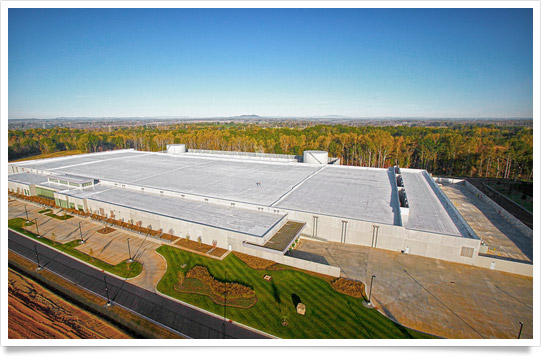Apple Data Center Does Fuel Cell Industry a Huge Favor
Apple is doubling the size its fuel cell installation at its new North Carolina data center, making it a proving ground for large-scale on-site energy at data centers.

In papers filed with the state’s utilities commission last month, Apple indicated that it intends to expand capacity from five megawatts of fuel cells, which are now runnning, to a maximum of 10 megawatts. The filing was originally spotted by the Charlotte News Observer.
Apple says the much-watched project (Wired actually hired a pilot to take photos of it) will be one of the most environmentally benign data centers ever built because it will use several energy-efficiency tricks and run on biogas-powered fuel cells and a giant 20-megawatt solar array.
Beyond Apple’s eco-bragging rights, this data center (and one being built by eBay) should provide valuable insights to the rest of the cloud computing industry. Apple likely won’t give hard numbers on expenses but, if all works as planned, it will validate data center fuel cells for reliable power generation at this scale.
Stationary fuel cells are certainly well proven, but multi-megawatt installations are pretty rare. Data center customers for Bloom Energy, which is supplying Apple in North Carolina, typically have far less than a megawatt installed. Each Bloom Energy Server, which takes up about a full parking space, produces 200 kilowatts.
By going to 10 megawatts of capacity, Apple can claim the largest fuel cell powered data center, passing eBay which earlier this year announced plans for six megawatts worth of fuel cells at a data center in Utah. (See, EBay Goes All-in With Fuel Cell-Powered Fuel Cell Data Center.) It also opens up new ways of doing business.
Using fuel cells at this scale potentially changes how data center operators use grid power and traditional back up diesel generators. With Apple’s combination of its solar power and fuel cells, it appears the facility will be able to produce more than the 20 megawatts it needs at full steam. That means Apple could sell power back to the utility or even operate independently and use the grid as back up power—a completely new configuration.
Bloom Energy’s top data center executive Peter Gross told Data Center Insider that data center servers could have two power cords—one from the grid and one from the fuel cells. In the event of a power failure, those fuel cells could keep the servers humming, rather than the backup diesel generators.
Apple hasn’t disclose how much it’s paying for all this, but the utility commission filing indicates it plans to monetize its choice of biogas, rather than natural gas. The documents show that Apple is contracting with a separate company to procure biogas, or methane that is given off from landfills. Because it’s a renewable source, Apple can receive compensation for renewable energy credits.
Proving fuel cells and solar work in a mission-critical workload at this scale is one thing. Whether it makes economic sense for companies other than cash-rich Apple and eBay is something different. Apple and eBay could save some money by installing fewer diesel generators. Investing in solar also gives companies a fixed electricity cost for years ahead, shielding them from spikes in utilities’ power prices.
But some of the most valuable information on these projects will be how the numbers pencil out. That might help conservative data center designers to look at these technologies, which are substantially cleaner than the grid, more seriously.
Both operationally and financially, there’s a lot to learn down in Maiden. Let’s hope Apple is a bit more forthcoming about its data center than telling us what’s in the next iPhone.
Keep Reading
Most Popular
Large language models can do jaw-dropping things. But nobody knows exactly why.
And that's a problem. Figuring it out is one of the biggest scientific puzzles of our time and a crucial step towards controlling more powerful future models.
The problem with plug-in hybrids? Their drivers.
Plug-in hybrids are often sold as a transition to EVs, but new data from Europe shows we’re still underestimating the emissions they produce.
Google DeepMind’s new generative model makes Super Mario–like games from scratch
Genie learns how to control games by watching hours and hours of video. It could help train next-gen robots too.
How scientists traced a mysterious covid case back to six toilets
When wastewater surveillance turns into a hunt for a single infected individual, the ethics get tricky.
Stay connected
Get the latest updates from
MIT Technology Review
Discover special offers, top stories, upcoming events, and more.